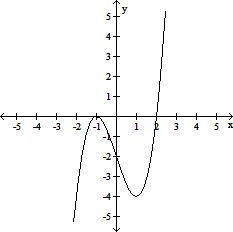Does the graph represent a function that has an inverse function?
A. Yes
B. No
Answer: A
You might also like to view...
A polynomial P(x) and a divisor d(x) are given. Use long division to find the quotient Q(x) and the remainder R(x) when P(x) is divided by d(x), and express P(x) in the form d(x)? Q(x) + R(x).P(x) = 3x4 - 2x3 - 10x2 + 15d(x) = x - 2
A. (x - 2)(3x3 - 4x2 - 2x - 4) + 7 B. (x - 2)(3x3 + 4x2 - 2x + 11) + 22 C. (x - 2)(3x3 + 4x2 - 2x - 4) + 7 D. (x - 2)(3x3 + 4x2 + 2x + 4) + 22
Determine whether f is continuous at c.f(x) =  ; c = -2
; c = -2
A. continuous B. not continuous
Solve the problem. Give an exact answer and an approximation to the nearest tenth.The diagram below shows a rope connecting the top of a pole to the ground. How tall is the pole?
A.  yd ? 17.8 yd
yd ? 17.8 yd
B.  yd ? 1.7 yd
yd ? 1.7 yd
C.  yd ? 8.7 yd
yd ? 8.7 yd
D.  yd = 37.5 yd
yd = 37.5 yd
Suppose that the function with the given graph is not f(x), but f'(x). Find the open intervals where f(x) is increasing or decreasing as indicated. Decreasing
A. (-?, -1), (-1, 2) B. (-1, 2) C. (-?, 2) D. (-?, 2)